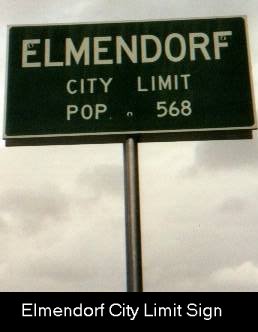
| Sandra L. Christian and Elsa Hernandez | Spring 2001 |
| History 1302 | Hines |

Some individuals who gained experience by serving in Elmendorf have moved on to higher positions. For example, Peter Sakai, who served as City Attorney for eight years, is now the judge of the Bexar County Juvenile Court. Charlie Gonzales, son of Henry B. Gonzales, a municipal judge (although he was not born and raised in Elmendorf), is now a U.S. Congressman. John Longoria, who actually volunteered as city attorney for Elmendorf, was later elected to county and state positions (information gathered by Mr. Simon Tarin).
The brick factory is said by some citizens to be the main employer of Elmendorf at one time. Ferdinand Wahne, who was at one time the general manager, estimates that the factory employed up to 100 people. He described the brick- making process in full (see appendix). The brick factory operated until the company was sold around 1989.

Elmendorf also had several other small businesses. There was a doctor's office, lawyer's office, grocery store, clothing store, drug store, service station, meat market, barber shop, and train depot. Sam Pena was the water operator. He would ride around with barrels of water in his cart and sell the water to townspeople. However, as Elmendorf began to shrink when people moved into San Antonio, these businesses began to disappear, one by one. Among the only businesses in Elmendorf now are DeLeon's store, which goes back at least 70 years, the Yellow Rose Cafe, and Roy's Place, a cafe and bar (interview: Bonnie DeLeon).
Transportation in Elmendorf was at first by horseback or horse and buggy. Of course, longer distances were traveled on the railroad that went through the town. However, one citizen had vivid memories of seeing her first car in 1901. Estella Tarin Liedecke was riding a horse on her way to school on Corpus Christi Road, when she saw what she described as a "'huge spider creeping down the dirt road with a cloud of dust trailing behind.' She then climbed off the horse and held the reins, thinking the horse would be scared. She had heard about cars, and she realized this must be one of those," as related by her grandson ("Liedecke's Ancestors Founded S.A. in 1731").
SOCIAL ORGANIZATIONS:
St. Anthony's Church is the largest church in Elmendorf, and it is still attended today. However, the old building has long since been torn down, and a new, bigger one stands in its place.
Elmendorf also has a large number of graveyards for such a small town. There are at least five graveyards,
including one that is an all-black cemetery with an estimated 20 bodies. This graveyard is now overgrown. One of the other
graveyards has the remains of soldiers who fought in the Texas Revolution. Various families in Elmendorf also have their own
private graveyards.
PEOPLE OF ELMENDORF
One particular Elmendorf teacher is of interest. The late Jane Terrell Ball taught for 18 years. Aside from Elmendorf, she also taught in Rio Medina and the Borrego community. She earned her teaching certificate by attending Our Lady of the Lake University and what is now Southwest Texas State University. It was while teaching in Elmendorf that Jane met her husband Raymond X. Ball, whom she married in Elmendorf at the age of 23 in 1926. When the town was incorporated, her husband became the first mayor. Jane was appointed by President Franklin D. Roosevelt in 1940 as postmaster, and served in her community for 27 years. She had memories of when the Bookmobile first began coming to Elmendorf in 1938. The Bookmobile parked at the school every two weeks from September through May, but it parked at the Ball home for the summer. Jane instilled in her children her own love of reading ("Ball, 87, Teacher and Postmaster").

Among the very honorable people in Elmendorf is Amos Longoria, after whom the post office was named. He was drafted at the age of 18 in World War II after his two older brothers were already serving. He volunteered to serve overseas and because he was already overseas at his graduation date, his younger sister Bonnie DeLeon was asked to recieve his diploma for him. He was killed in Italy at the age of 19. State Representative John Longoria, who was Amos Longoria's nephew, worked with Frank Tejeda to have the U.S. Post Office in Elmendorf named after him (interview: Bonnie DeLeon and "Elmendorf War Hero to be Honored").
There is also a street in Ranchview Estates named after Edward Tarin. He, like Amos Longoria, was killed in action, but Edward served in Vietnam. He was drafted around the age of 21, and after serving for 11 months, he was killed on February 26, 1968. Edward had three other brothers, all of whom also served in the Vietnam War at the same time (interview: Simon Tarin).
The late Estella Tarin Liedecke married John Liedecke in Elmendorf in 1920. In those days, men had much respect when courting women. John's uncle asked Estella's parents for her hand in marriage to John. His request was in the form of a letter delivered wrapped in a silk handkerchief. Then, according to custom, Estella's parents returned the answer eight days later and the couple was married in June of the next year.
Estella was a direct descendant of Juan Leal, one of the original Canary Islanders who founded San Antonio in 1731. Also, her great-grandfatehr, Vicente Tarin, fought in the Texas Revolution as a member of Capt. Juan Seguin's Company from February 22 to July 15, 1836 ("Liedecke's Ancestors Founded S.A. in 1731").
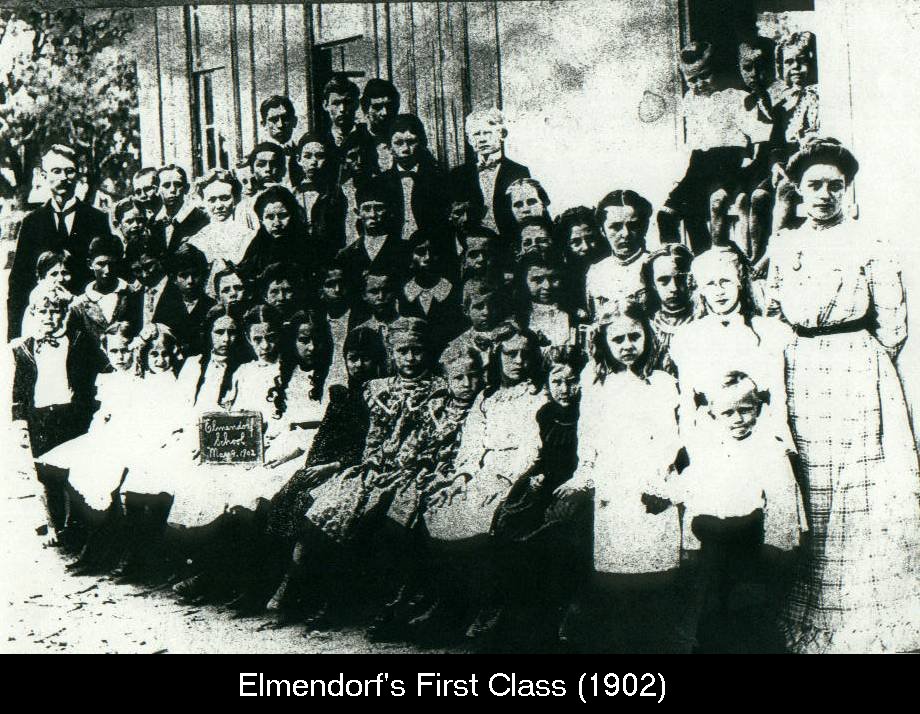
SCHOOL HISTORY
Elmendorf had a public school that was opened in 1902 with about 48 students. It was located on Old Corpus Christi Highway and old Goliad Road. The first building consisted of one room, but later two more rooms were added. In 1926, a new two-story high school was built. A well furnished the water, and heat was provided by wood-burning stoves. Electricity was used beginning in 1929. The earliest known trustees were Henry Keller, Adolph Werner, and Frankie S. Ball (1914 - 1915). Others were Fred Hobrecht, K.J. Smith, Adolph Lambrecht, and Otto Weller (1924 - 1925). Some of its earliest teachers were Mollie Martin, Nell Keller, Stella Smith, a husband and wife by the last name of Donaho, and Jane Terrill. Some of the students were from the families of the Hobrechts, K.J. Smiths, Balls, Lambrechts, Imhoffs, and Otto Wellers.
When East Central High School opened in 1950, the Elmendorf High School was closed and students were included in the new East Central district. The lower grades remained until their transfer to John Glenn in 1957, or Harmony in 1962. On November 2, 1971, the old school building was declared a safety hazard and the land was delegated to the East Central School District. In turn, East Central allowed the land to become a park, and there is now a playground and basketball court on the property.
Elmendorf also had a softball team. The team of eight boys won the Bexar County Interscholastic Combination (junior and senior students) Softball Championship in 1938 (East Central Historical Society).
Although there is very little information on the subject of a Negro school in Elmendorf, it is true that one existed. According to two available photographs, the school at one time consisted of a black teacher and eight black students. Their schoolhouse was a one-room building (East Central Historical Society).
"THE BUTCHER OF ELMENDORF"

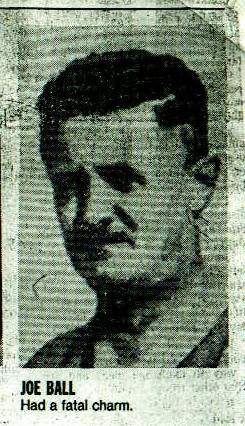
A well-known story of Elmendorf is the Joe Ball story. Part speculation, part fact, this story certainly is a bone-chiller. Joe Ball was a bootlegger in the 1930's. He employed a number of barmaids at his tavern, and it was rumored that he may have had affairs with one or more of the barmaids. However, as many as seven or eight women met a horrible fate. Joe Ball kept a pond of seven pet alligators near his tavern. As the story goes, Joe killed the women, mutilated their corpses by dismembering, and fed them to his alligators. Two bodies have been found, but the other women very mysteriously disappeared.
An investigation was led by Bexar County Sheriff's Captain Johnny Clavenhagen. Supposedly when he went to Joe's bar to bring him in for questioning, Joe agreed but asked to get his money bags in order to close his bar first. Joe then went to his counter and pulled out a gun. He shot and killed himself right there. Joe Ball has been called the "Bluebeard of South Texas." People may never know the truth about what happened to all of those women, but the story of the "Alligator Man" will live on for generations to come, perhaps changing each time it is told (San Antonio Light "The Butcher of Elmendorf" and KENS 5 Report).
RECENT CONFLICT
Recently, there has been some political conflict in Elmendorf. The police department had been accused of unethical conduct, and was voted by a majority to disband in early 2000. However, after the election of a new mayor a short time later, the department was reinstated. There also have been charges by the District Attorney against officials in Elmendorf because of violations of the Open Meeting Act. After the violations, city leaders illegally paid nearly $41,000 of municipal money for attorney's fees to protect themselves against lawsuit (Various Wilson County News articles).
City water has been brought into Elmendorf. This is due in a large part to George Ozuna, Jr., City Engineer. Mr. Ozuna is still working to bring physical improvements into the town of Elmendorf, particularly in regards to building new subdivisions. Interestingly, the learning center at Palo Alto College is also named after Ozuna, who was responsible in a large part for the existence of Palo Alto College (interview: Mr. Ozuna).
WEBSITES
Elmendorf in the Texas Handbook
USRG Elmendorf Restaurant Guide
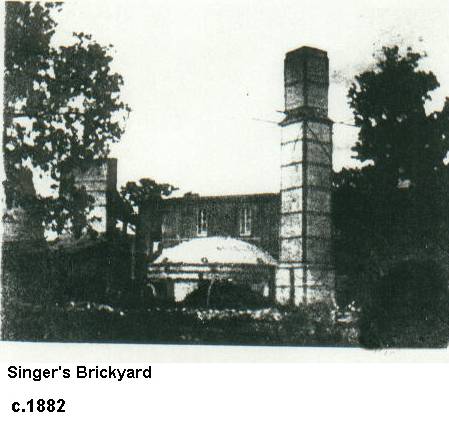 Ferdinand Wahne described the brick-making process in full, as follows:
Ferdinand Wahne described the brick-making process in full, as follows:
First, clay was brought in from across the river in buckets. The buckets were carried on a trolley. Once the clay reached the factory, a mill pulverized the clay. This ground clay was then put into a mixing vat called a "pug mill." After it was mixed, a machine molded and cut the bricks. This was a very dangerous machine. Many people who operated this machine had fingers cut off. After the bricks were cut, they were put into a dryer. After drying, they were moved to the kiln, which had to be maintained at a temperature of up to 2000 degrees F. The kiln was originally heated by coal. Later it began to use gas. Workers had three shifts to work the kiln 24 hours a day. The bricks remained in the kiln for at least a week. After the bricks came out of the kiln, they were shipped out by train. Also, citizens came by with pickups to purchase their own loads (interview: Mr. and Mrs. Wahne).
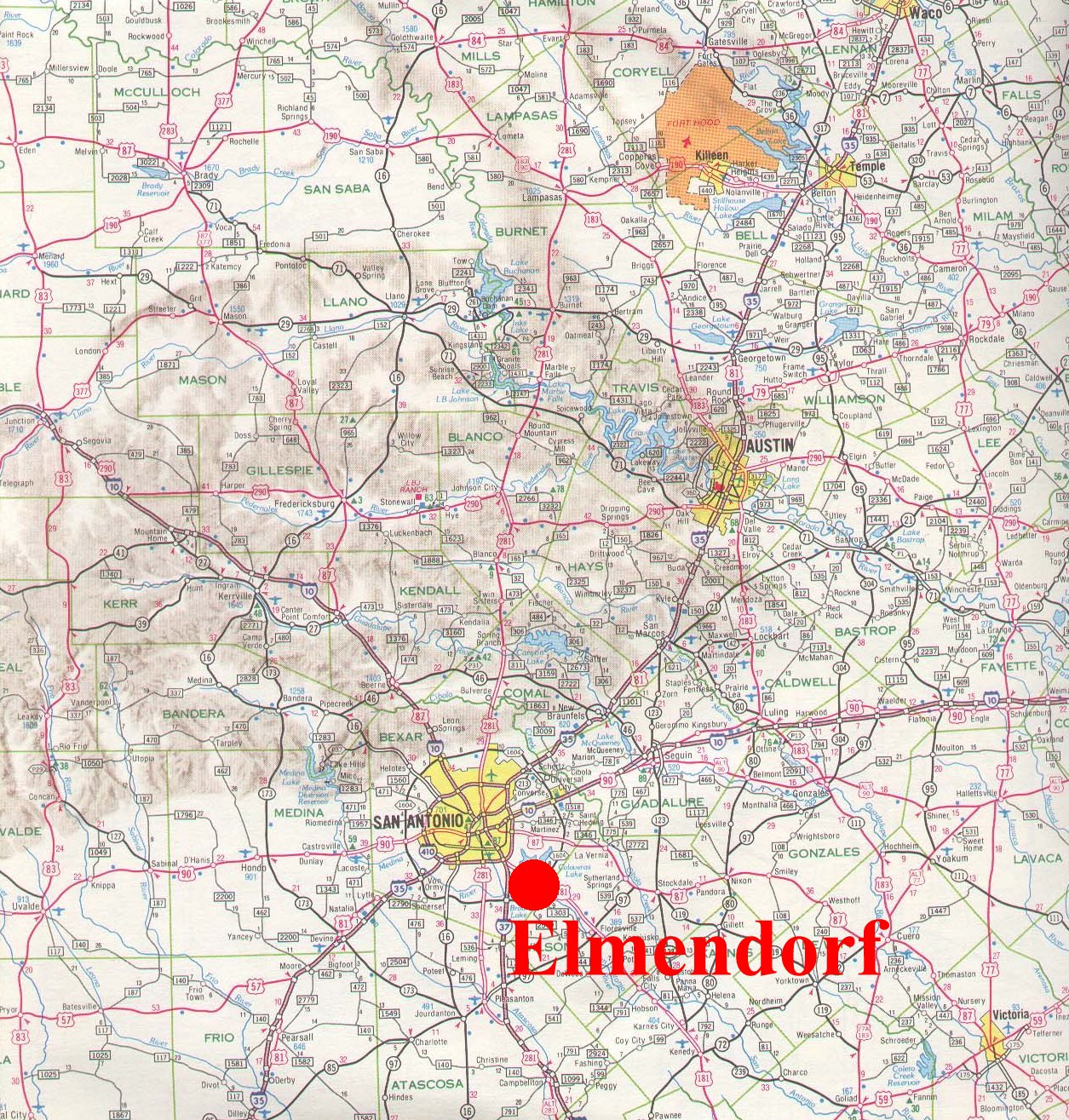
People:
Edward Tarin (former mayor) A very special thanks goes out to Mr. Tarin for ALL the wonderful, unceasing help he has provided us for this project. Without him, much of this website would not be possible.
Raymond Reynolds (citizen and former city council member) Mr. Reynolds was extremely helpful in giving us the "grand tour" of Elmendorf in his pickup truck.
Mr. and Mrs. Ferdinand Wahne (Mr. Wahne former mayor and manager of brick factory) Mr. and Mrs. Wahne entertained us in their home with long stories of the brick factory. They provided us much information on this main enterprise of Elmendorf, without which Elmendorf may not even have existed.
George Ozuna, Jr. (City Engineer) Mr. Ozuna entertained us in his office and answered many questions about the recent and future developments in the city.
Bonnie Longoria DeLeon (sister of Amos Longoria) Mrs. Longoria shared with us stories about her brother and the histories of several businesses in Elmendorf.
East Central Historical Society Another very special thanks goes to these ladies for the wealth of information they provided about the school history, and the wonderful pictures.
Film:
Kens 5 Report, "The Butcher of Elmendorf," date unknown
Print:
Town Ordinance #16412 v. 625 p. 128 November 5, 1963
San Antonio Light "The Butcher of Elmendorf" by Allan Turner; October 25, 1981
"A Twentieth Century History of Southwest Texas"; volume I, 1907 p. 173-176; The Lewis Publishing Company; provided by Daughters of the Republic Library
Wilson County News (various articles)
San Antonio Express News "Elmendorf War Hero to be Honored" by Anastasia Cisneros-Lunsford; November 20, 1996
San Antonio Express News "Ball, 87, Teacher and Postmaster"; December 5, 1990
San Antonio Express News "Liedecke's Ancestors Founded S.A. in 1731"; October 24, 1990